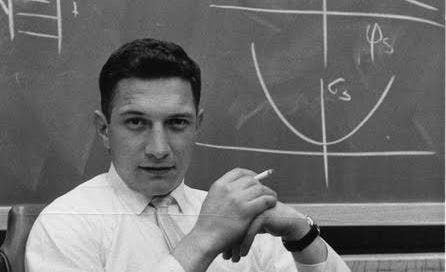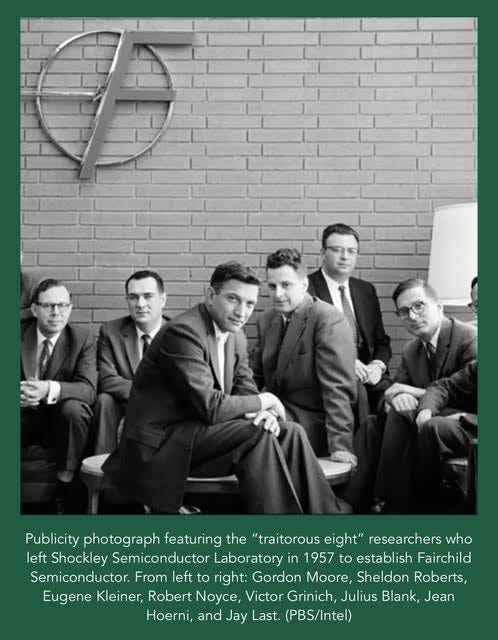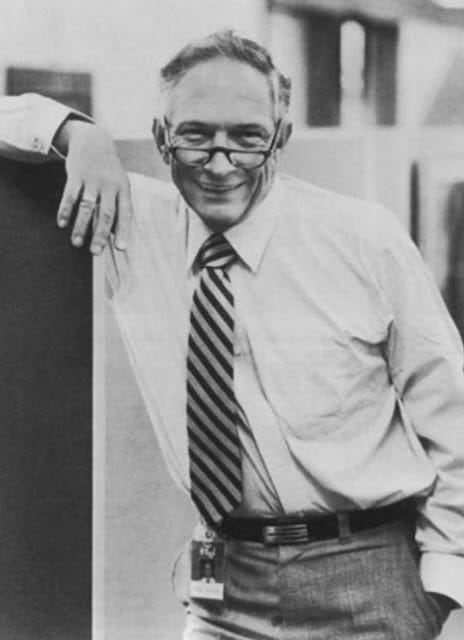Before there was Steve.
Before Bill.
Before Woz.
And long before Sergey and Larry and Zuck.
There was Bob.
Bob Noyce.
A man who was part engineer, part entrepreneur, part visionary.
A man whose name might not be on the tip of the tongue of the average tech bro, but whose influence permeates every smartphone, every laptop, and yes, every tweet.
Robert “Bob” Noyce, known as the “Mayor of Silicon Valley,” was a visionary whose blend of technical brilliance and human leadership helped create the tech world as we know it.
If Silicon Valley had a Mount Rushmore, his face would be chiseled right alongside the best of them—and he’d probably be the guy who figured out how to optimize the laser cutter to make art out of South Dakota granite.
Robert Noyce (December 12, 1927 - June 3, 1990) was born in Burlington, Iowa.
After excelling in high school, he went to Grinnell College where his love for physics blossomed.
But even here, it wasn’t just the equations that excited him; it was the potential applications. How could science make life better, easier, more exciting? That question would drive his career—and his legacy.
After stints in the East working on transistors, Bob made his way to California and an area of apricot and prune trees not far from Stanford University.
It was a valley for sure, but it was yet to become the famous “Silicon Valley.”
You see, Bob had a hand in that, too.
In 1957, he and 7 colleagues broke away from the Shockley Semiconductor Laboratory. SSL was run by the brilliant, but domineering Nobel Prize winner William Shockley.
Feeling stifled and undervalued, the “Traitorous Eight” as they had become known, formed a new company called “Fairchild Semiconductor.” Funded by the wealthy inventor Sherman Fairchild, this would be no ordinary company. It would become a place that invented the world as we know it.
You see, at Fairchild Noyce and crew invented the integrated circuit.
Let’s pause on that for a moment.
The integrated circuit.
Think of the integrated circuit as the seed that sprouted the entire forest of modern technology. Without it, there’s no personal computer, no internet, no TikTok algorithm making us question our life choices at 3 a.m.
Noyce’s invention wasn’t just a technological breakthrough, it was a philosophical one as well. It showed that complex systems could be miniaturized and made accessible. It made the chance to scale and apply technology unprecedented and undeniable. It set the stage for the full democratization of information decades later.
Now beyond the impressive feats of technology, Noyce also re-invented the way we work.
In an era when most companies were rigid hierarchies, Noyce championed openness and collaboration. His management philosophy was rooted in trust, autonomy, and a refusal to micromanage. If you worked for Noyce, you were expected to bring your best ideas to the table — and you were given the freedom to run with them.
He started developing his leadership style at Fairchild and then perfected it at the next company he invented — Intel.
Yep, Noyce co-founded Intel in 1968 with Gordon Moore (yes, the Moore’s Law guy). And he embedded these more democratic values into the company’s DNA. Intel’s early success wasn’t just about building better chips; it was about building a culture that attracted the best minds and gave them the space to innovate.
They created a different kind of company culture. Gone were the rigid hierarchies and closed office doors of traditional corporations. Noyce instituted what he called "horizontal management."
Everyone ate in the same cafeteria.
There were no reserved parking spots.
Ideas could come from anywhere. And merit mattered more than titles.
Sound familiar? That's because these practices became the template for Silicon Valley culture. When a young Steve Jobs visited Intel in the 1970s, he took notes – lots of them. (And it seems Jay Chiat took plenty of notes from those notes as so much of Noyce’s culture was the culture of Chiat/Day.)
So why should you care about Robert Noyce today?
First, his technical innovations are more relevant than ever. As we enter the age of artificial intelligence and quantum computing, the integrated circuit remains the foundation. Every smartphone, every server farm, every piece of modern technology builds on Noyce's work.
Second, his management philosophy offers lessons for today's workplace challenges. As companies grapple with remote work, innovation, and employee engagement, Noyce's ideas about flat hierarchies and merit-based advancement feel surprisingly current.
Third, and perhaps most importantly, Noyce understood something crucial about innovation: it's not just about individual genius, but about creating the right environment for creativity to flourish.
Noyce truly believed that technology could “elevate the human condition.”
So as you read this on your smartphone or laptop, take a moment to remember Robert Noyce. Without him, the device in your hands might still be science fiction.
And the next time you think about leadership and innovation, consider his example. In an age of volatility, complexity and transformation, we could use more leaders who combine technical brilliance with empathy and humanity.
People who understand that the best innovations come from environments where creativity can thrive.









brilliant but domineering Nobel Prize winner William Shockley.
Also, racist.
Also, Eugenecist.
I love these profiles. Hard for us to appreciate how revolutionary his ideas were at the time, as we take them for granted today.